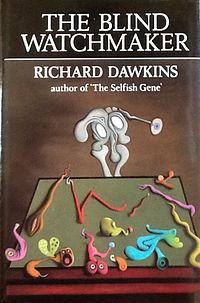The Blind Watchmaker

First edition cover
|
|
| Author | Richard Dawkins |
|---|---|
| Country | United Kingdom |
| Language | English |
| Subject | Evolutionary biology |
| Publisher | Norton & Company, Inc |
|
Publication date
|
1986 |
| Media type | Print, e-book |
| ISBN | |
| OCLC | 35648431 |
| 576.8/2 21 | |
| LC Class | QH366.2 .D37 1996 |
| Preceded by | The Extended Phenotype |
| Followed by | River Out of Eden |
The Blind Watchmaker: Why the Evidence of Evolution Reveals a Universe without Design is a 1986 book by Richard Dawkins, in which Dawkins presents an explanation of, and argument for, the theory of evolution by means of natural selection. He also presents arguments to refute certain criticisms made on his first book, The Selfish Gene. (Both books espouse the gene-centric view of evolution.) An unabridged audiobook edition was released in 2011, narrated by Richard Dawkins and Lalla Ward.
In his choice of the title for this book, Dawkins refers to the watchmaker analogy made famous by William Paley in his 1802 book Natural Theology. Paley, writing long before Charles Darwin published On the Origin of Species in 1859, held that the complexity of living organisms was evidence of the existence of a divine creator by drawing a parallel with the way in which the existence of a watch compels belief in an intelligent watchmaker. Dawkins, in contrasting the differences between human design and its potential for planning with the workings of natural selection, therefore dubbed evolutionary processes as analogous to a blind watchmaker.
To dispel the idea that complexity cannot arise without the intervention of a "creator", Dawkins uses the example of the eye. Beginning with a simple organism, capable only of distinguishing between light and dark, in only the crudest fashion, he takes the reader through a series of minor modifications, which build in sophistication until we arrive at the elegant and complex mammalian eye. In making this journey, he points to several creatures whose various seeing apparatus are, whilst still useful, living examples of intermediate levels of complexity.
In developing his argument that natural selection can explain the complex adaptations of organisms, Dawkins' first concern is to illustrate the difference between the potential for the development of complexity as a result of pure randomness, as opposed to that of randomness coupled with cumulative selection. He demonstrates this by the example of the weasel program. Dawkins then describes his experiences with a more sophisticated computer model of artificial selection implemented in a program also called The Blind Watchmaker, which was sold separately as a teaching aid (open source implementations are currently available, as are more advanced versions of the idea).
...
Wikipedia
